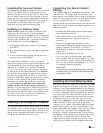4
YY
YY
Y
English
L-2448B Introduction
Auger Unit (Figure 2)
The auger unit contains the evaporator barrel, auger
rotor, gearbox, motor, water reservoir, and expansion
device. The unit comes with quick connect refrigerant
fittings and is pre-charged with refrigerant from the
factory. The unit has plug-and-play electrical connec-
tions to the control box and the ice level sensor.
Control Panel (Figure 3)
The control panel contains the system function switch
as well as system indicator lights. It is a user interface
that enables a visual indicator of system activity, such
as whether the system is running or has a fault.
Linesets
Linesets are generally made of copper tubing which is
connected to the auger at one end and the condensing
unit at the other. The liquid line is ¼" copper tubing,
while the suction line is ½" copper tubing. The suction
line comes pre-insulated to prevent frost. Flexible
sections are available where one part moves in relation
to another, such a lifting deck.
System Controls
The ice maker system is controlled by logic that is
programmed into the SmartRelay. The SmartRelay
controls all operations of the system, and gives visual
indications of activity to the user via the control panel.
The logic system takes into account low refrigerant
pressure, high refrigerant pressure, low feedwater for
ice making, blocked ice delivery system, and auger
motor start error. The control box contains a System
Reset switch for use when the control locks out due to
a sustained fault.
Ice Box
The ice box where the ice is to be dumped should be
insulated, if possible, with at least 2" of insulation to
help keep the ice as long as possible. It is also helpful
to install a drain at the opposite end of the box from
the ice input.
Seawater System (Figure 1)
The cupro-nickel coaxial tube design allows for effi-
cient exchange of heat between the seawater and the
hot refrigerant. The condensing unit may be hooked up
to either its own single-station pump, or to a larger,
multi-station pump via a pump relay box. The seawater
system should consist of a through-hull fitting,
seacock, strainer, seawater pump, seawater hose, and
overboard discharge.
Freshwater Supply
Freshwater supply for ice making should be provided
via the ¼" male flare fitting on the auger unit. Provide
water with pressure of at least 15 PSI. An in-line water
filter is required to help prevent clogging of the needle
valve in the water reservoir.
Refrigerant Charge
The condensing unit, the auger unit, and the linesets
are all pre-charged with the correct amount of R134a
refrigerant. No charge adjustment should be necessary
upon installation.
Sight Glass/Moisture Indicator (Figure 1)
A sight glass is provided on the condensing unit to
provide quick access to a couple of pieces of system
information. The sight glass will provide visual identifi-
cation of refrigerant charge status (empty or full.) The
sight glass also houses a moisture indicating element
which can help in troubleshooting.
Quick Connect Fittings (Figure 1)
The quick connect (QC) fittings allow for all parts of
the unit to be factory evacuated and precharged with
refrigerant. They allow for easy and quick installation in
the field. They are polarized so they can’t be hooked
up incorrectly. They can be reused over time and again
if the unit is ever relocated.
Constant Pressure Valve (Figure 4)
The constant pressure valve is used as the expansion
valve of the refrigerant system. It allows high pressure
liquid to become low pressure liquid and start the
refrigeration process. The constant pressure valve is
very simple and reliable, and provides for a constant
system pressure over a wide range of ambient and
seawater temperatures. The valve pressure is set at
the factory, and generally needs no field adjustment.
The recommended pressure is 9-10 PSI.
Misadjustment of the valve can cause reduced ice
production, damage to components, and voiding of the
warranty.


















